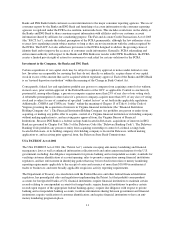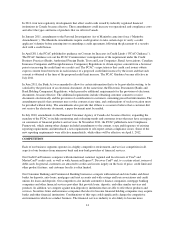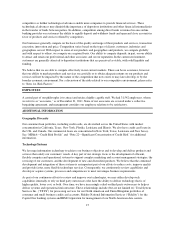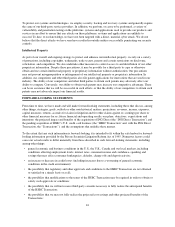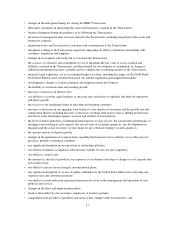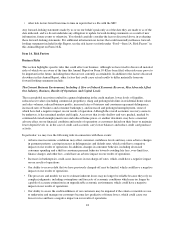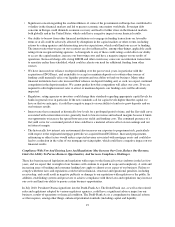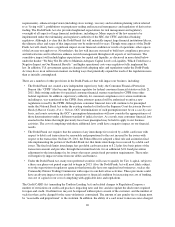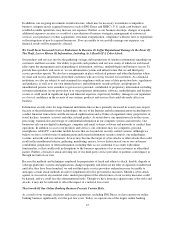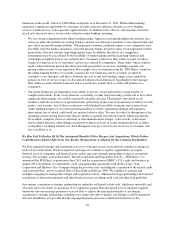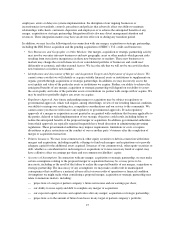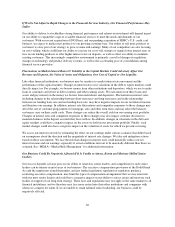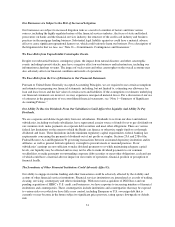Capital One 2011 Annual Report Download - page 41
Download and view the complete annual report
Please find page 41 of the 2011 Capital One annual report below. You can navigate through the pages in the report by either clicking on the pages listed below, or by using the keyword search tool below to find specific information within the annual report.on pre-existing card balances has been significantly restricted. Card issuers are generally prohibited from raising
rates on pre-existing balances when generally prevailing interest rates change. Moreover, the circumstances
under which a card issuer can raise the interest rate on pre-existing balances of a customer whose risk of default
increases are restricted. As a result, the rules implementing the Credit CARD Act could make the card business
generally less resilient in future economic downturns.
Under the various state and federal statutes and regulations, we are required to observe various data security and
privacy-related requirements, including establishing information security and data security breach response
programs and properly authenticating customers before processing or enabling certain types of transactions or
interactions. Future federal and state legislation and regulation could further restrict how we collect, use, share
and secure customer information. The failure to observe any one or more of these requirements could subject us
to litigation or enforcement actions and impact some of our current or planned business initiatives.
Certain laws and regulations, and any interpretations and applications with respect thereto, may benefit
consumers, borrowers and depositors, but not stockholders. The legislative and regulatory environment is beyond
our control, may change rapidly and unpredictably and may negatively influence our revenue, costs, earnings,
growth and capital levels. Our success depends on our ability to maintain compliance with both existing and new
laws and regulations. For a description of the laws and regulations to which we are subject, please refer to
“Supervision and Regulation” in “Item 1. Business.”
We May Experience Increased Delinquencies And Credit Losses.
Like other lenders, we face the risk that our customers will not repay their loans. Rising losses or leading
indicators of rising losses (such as higher delinquencies, higher rates of non-performing loans, higher bankruptcy
rates, lower collateral values or elevated unemployment rates) may require us to increase our allowance for loan
and lease losses, which may degrade our profitability if we are unable to raise revenue or reduce costs to
compensate for higher losses. In particular, we face the following risks in this area:
•Missed Payments. Our customers may miss payments. Loan charge-offs (including from bankruptcies) are
generally preceded by missed payments or other indications of worsening financial condition for our
customers. Customers are more likely to miss payments during an economic downturn or prolonged periods
of slow economic growth. In addition, we face the risk that consumer and commercial customer behavior
may change (for example, an increase in the unwillingness or inability of customers to repay debt), causing
a long-term rise in delinquencies and charge-offs.
•Estimates of Inherent losses. The credit quality of our portfolio can have a significant impact on our
earnings. We allow for and reserve against credit risks based on our assessment of credit losses inherent in
our loan portfolios. This process, which is critical to our financial results and condition, requires complex
judgments, including forecasts of economic conditions. We may underestimate our inherent losses and fail
to hold a loan loss allowance sufficient to account for these losses. Incorrect assumptions could lead to
material underestimates of inherent losses and inadequate allowance for loan and lease losses. In addition,
our estimate of inherent losses impacts the amount of allowances we build to account for those losses. In
cases where we modify a loan, if the modifications do not perform as anticipated we may be required to
build additional allowance on these loans. The increase or release of allowances impacts our current
financial results.
•Underwriting. Our ability to assess the credit worthiness of our customers may diminish.If the models and
approaches we use to select, manage and underwrite our consumer and commercial customers become less
predictive of future charge-offs (due, for example, to rapid changes in the economy, including the
unemployment rate), our credit losses may increase and our returns may deteriorate.
•Business Mix. Our business mix could change in ways that could adversely affect credit losses.We engage
in a diverse mix of businesses with a broad range of credit loss characteristics.Consequently, changes in our
business mix may change our charge-off rate.
21


